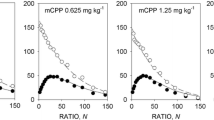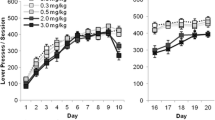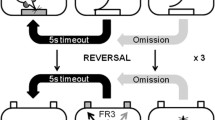Abstract
Rationale
Performance on progressive ratio schedules has been proposed as a means of assessing the effects of drugs on the efficacy of reinforcers. A mathematical model (Killeen PR (1994) Mathematical principles of reinforcement. Behav Brain Sci 17:105–172) affords a basis for quantifying the effects of drugs on progressive ratio schedule performance. The model postulates a bitonic function relating response rate and ratio size. One parameter of the function, a, expresses the motivational effect of the reinforcer, whereas another parameter, δ, expresses the minimum time needed to execute a response, and is regarded as an index of ‘motor capacity’. Previously we found that the atypical antipsychotic clozapine increased a, indicating an increase in reinforcer efficacy; a similar effect was observed with the 5-hydroxytryptamine (5-HT)1A receptor agonist 8-hydroxy-2-(di-n-propylamino)tetralin (8-OH-DPAT). It has been suggested that some of clozapine’s behavioural effects are mediated by agonistic action at 5-HT1A receptors.
Objective
This study was conducted to compare the effects of clozapine and 8-OH-DPAT on progressive ratio schedule performance.
Methods
Rats were trained under a time-constrained progressive ratio schedule (50-min sessions). In experiment 1, they received acute doses of clozapine (4 mg kg−1) and 8-OH-DPAT (100 μg kg−1), alone and in combination with the 5-HT1A receptor antagonist N-[2-(4-[2-methoxyphenyl]-1-piperazinyl)ethyl]-N-2-yridinylcyclohexanecarboxamide (WAY-100635; 30 μg kg−1). In experiment 2, the effects of clozapine (2, 4 and 8 mg kg−1) and 8-OH-DPAT (25, 50 and 100 μg kg−1) were compared between intact rats and rats whose 5-HTergic pathways had been ablated by 5,7-dihydroxytryptamine (5,7-DHT).
Results
In both experiments, clozapine and 8-OH-DPAT increased a and δ. In experiment 1, WAY-100635 abolished the effect of 8-OH-DPAT on a and δ, but did not alter clozapine’s effects on these parameters. In experiment 2, the effects of clozapine and 8-OH-DPAT did not differ between sham-lesioned and 5,7-DHT-lesioned rats.
Conclusions
The results confirm previous findings on the effects of clozapine and 8-OH-DPAT on progressive ratio schedule performance. 8-OH-DPAT’s effects are probably mediated by post-synaptic 5-HT1A receptors; clozapine’s effects are mediated by a different mechanism, which does not appear to involve 5-HT1A receptors and which does not depend upon an intact 5-HTergic pathway.




Similar content being viewed by others
References
Aberman JE, Ward SJ, Salamone JD (1998) Effects of dopamine antagonists and accumbens dopamine depletions on time-constrained progressive-ratio performance. Pharmacol Biochem Behav 61:341–348
Bantick RA, Deakin JFW, Grasby PM (2001) The 5-HT1A receptor in schizophrenia: a promising target for novel atypical neuroleptics? J Psychopharmacol 15:37–46
Barnes NM, Sharpe T (1999) A review of central 5-HT receptors and their function. Neuropharmacology 38:1083–1152
Barr AM, Philips AG (1998) Withdrawal following repeated exposure to d-amphetamine decreases responding for a sucrose solution as measured by a progressive ratio schedule of reinforcement. Psychopharmacology 141:99–106
Bizo LA, Killeen PR (1997) Models of ratio schedule performance. J Exp Psychol Anim Behav Processes 23:351–367
Blake T-J, Tillery CE, Reynolds GP (1998) Antipsychotic drug affinities at alpha2-adrenoceptor subtypes in post-mortem human brain. J Psychopharmacol 12:151–154
Body S, Kheramin S, Mobini S, Ho M-Y, Velazquez-Martinez DN, Bradshaw CM, Szabadi E (2002) Antagonism by WAY-100635 of the effects of 8-OH-DPAT on performance on a free-operant timing schedule in intact and 5-HT-depleted rats. Behav Pharmacol 13:603–614
Body S, Kheramin S, Ho M-Y, Miranda Herrera F, Bradshaw CM, Szabadi E (2004) Effects of fenfluramine on free-operant timing behaviour: evidence for involvement of 5-HT2A receptors. Psychopharmacology 176:154–165
Cheeta S, Brooks S, Willner P (1995) Effects of reinforcer sweetness and the D2/D3 antagonist raclopride on progressive ratio operant responding. Behav Pharmacol 6:127–132
Chou Y-H, Halldin C, Farde L (2003) Occupancy of 5-HT1A receptors by clozapine in the primate brain: a PET study. Psychopharmacology 166:234–240
Corrigan PW, Reinke RR, Landsberger SA, Charate A, Toombs GA (2003) The effects of atypical antipsychotic medications on psychosocial outcomes. Schizophr Res 63:97–101
Dekeyne A, Rivet J-M, Gobert A, Millan MJ (2001) Generalization of serotonin (5-HT)1A agonists and the antipsychotics, clozapine, ziprasidone and S16924, but not haloperidol, to the discriminative stimuli elicited by PD128,907 and 7-OH-DPAT. Neuropharmacology 40:899–910
De Vry J (1995) 5-HT1A receptor agonists: recent developments and controversial issues. Psychopharmacology 121:1–26
Hamill S, Trevitt JT, Nowend KL, Carlson BB, Salamone JD (1999) Nucleus accumbens dopamine depletion and time-constrained progressive ratio performance: effects of different ratio requirements. Pharmacol Biochem Behav 64:21–27
Hertel P, Fagerquist MV, Svensson TH (1999) Enhanced cortical dopamine output and antipsychotic-like effects of raclopride by α2 adrenoceptor blockade. Science 286:105–107
Ho M-Y, Body S, Kheramin S, Bradshaw CM, Szabadi E (2003) Effects of 8-OH-DPAT and WAY-100635 on performance on a time-constrained progressive-ratio schedule. Psychopharmacology 167:137–144
Hodos W (1961) Progressive ratio as a measure of reward strength. Science 134:943–944
Hodos W, Kalman G (1963) Effects of increment size and reinforcer volume on progressive ratio performance. J Exp Anal Behav 6:389–392
Hoyer D, Hannon JP, Martin GR (2002) Molecular, pharmacological and functional diversity of 5-HT receptors. Pharmacol Biochem Behav 71:533–554
Ichikawa J, Ishii H, Bonaccorsco S, Fowler WL, O’Laughlin IA, Meltzer HY (2001) 5-HT2A and D2 receptor blockade increases cortical DA release via 5-HT1A receptor activation: a possible mechanism of atypical antipsychotic-induced cortical dopamine release. J Neurochem 76:1521–1531
Imai H, Steindler DA, Kitai ST (1986) The organization of divergent axonal projections of the midbrain raphe nuclei in the rat. J Comp Neurol 243:363–380
Kheramin S, Body S, Miranda Herrera F, Bradshaw CM, Szabadi E, Deakin JFW, Anderson IM (2005) The effect of orbital prefrontal cortex lesions on performance on a progressive ratio schedule: implications for models of inter-temporal choice. Behav Brain Res 156:145–152
Killeen PR (1994) Mathematical principles of reinforcement. Behav Brain Sci 17:105–172
Killeen PR, Sitomer MT (2003) MPR. Behav Processes 62:49–64
Killeen PR, Cate H, Tran T (1993) Scaling pigeons’ choice of feeds: bigger is better. J Exp Anal Behav 60:203–217
King DJ, Waddington JL (2004) Antipsychotic drugs and the treatment of schizophrenia. In: King DJ (ed) Seminars in psychopharmacology, 2nd edn. Gaskell, London, pp 316–380
Leysen JE (2000) Receptor profiles of antipsychotics. In: Ellenbrook BA, Cools AR (eds) Atypical antipsychotics. Birkhauser, Basel, pp 57–81
Meltzer HY (1999) The role of sertonin in antipsychotic drug action. Neuropsychopharmacology 21:106S–115S
Meltzer HY, Matsubara S, Lee J-C (1989) Classification of typical and atypical antipsychotic drugs on the basis of dopamine D-1, D-2 and serotonin-2 pK i values. J Pharmacol Exp Ther 251:238–246
Mobini S, Chiang T-J, Ho M-Y, Bradshaw CM, Szabadi E (2000) Comparison of the effects of clozapine, haloperidol, chlorpromazine and d-amphetamine on performance on a time-constrained progressive ratio schedule and on locomotor behaviour in the rat. Psychopharmacology 152:47–54
Müller-Spahn F (2002) Current use of atypical antipsychotics. Eur Psychiatr 17(suppl 4):377–384
Newman-Tancredi A, Gavaudan S, Conte C, Chaput C, Touzard M, Verriele L, Audinot V, Millan MJ (1998) Agonist and antagonist actions of antipsychotic agents at 5-HT1A receptors: a [35S]GTP S binding study. Eur J Pharmacol 355:245–256
Paxinos G, Watson C (1998) The brain in stereotaxic coordinates, 2nd edn. Academic, New York
Prinssen EPM, Kleven MS, Koek W (1999) Interactions between neuroleptics and 5-HT1A ligands in preclinical behavioral models for antipsychotic and extrapyramidal effects. Psychopharmacology 144:20–29
Reilly MP (2003) Extending mathematical principles of reinforcement into the domain of behavioral pharmacology. Behav Processes 62:75–88
Roberts DCS, Richardson NR (1992) Self-administration of psychostimulants using progressive ratio schedules of reinforcement. In: Boulton A, Baker G, Wu PH (eds) Neuromethods, vol 24: animal models of drug addiction. Humana, New York, pp 233–269
Rollema H, Lu Y, Schmidt AW (1997) Clozapine increases dopamine release in prefrontal cortex by 5-HT1A receptor activation. Eur J Pharmacol 338:R3–R5
Skjoldager P, Pierre PJ, Mittleman G (1993) Reinforcer magnitude and progressive ratio responding in the rat: effects of increased effort, prefeeding, and extinction. Learn Motiv 24:303–343
Stewart WJ (1975) Progressive ratio reinforcement schedules: a review and evaluation. Aust J Psychol 27:9–22
Wogar MA, Bradshaw CM, Szabadi E (1992) Impaired acquisition of temporal differentiation performance following lesions of the ascending 5-hydroxytryptaminergic pathways. Psychopharmacology 107:373–378
Young CD, Meltzer HY, Deutch AY (1998) Effects of desmethylclozapine on fos protein expression in the forebrain: in vivo biological activity of the clozapine metabolite. Neuropsychopharmacology 19:99–103
Zhang Z, Rickard JF, Asgari K, Body S, Bradshaw CM, Szabadi E (2005) Quantitative analysis of the effects of some ‘atypical’ and ‘conventional’ antipsychotics on progressive ratio schedule performance. Psychopharmacology, in press
Acknowledgements
This work was supported by the Wellcome Trust (Travelling Fellowship awarded to Z.Z.). We are grateful to Ms.V. K. Bak and Mr. R. W. Langley for skilled technical help.
Author information
Authors and Affiliations
Corresponding author
Additional information
Jonathan Francis Rickard (1977–2003), a gifted and dedicated Ph.D. student, made a major contribution to this work
Rights and permissions
About this article
Cite this article
Zhang, Z., Rickard, J.F., Body, S. et al. Comparison of the effects of clozapine and 8-hydroxy-2-(di-n-propylamino)tetralin (8-OH-DPAT) on progressive ratio schedule performance: evidence against the involvement of 5-HT1A receptors in the behavioural effects of clozapine. Psychopharmacology 181, 381–391 (2005). https://doi.org/10.1007/s00213-005-2258-7
Received:
Accepted:
Published:
Issue Date:
DOI: https://doi.org/10.1007/s00213-005-2258-7




